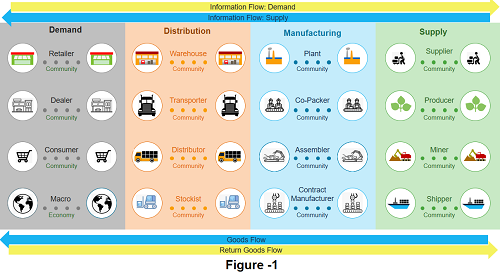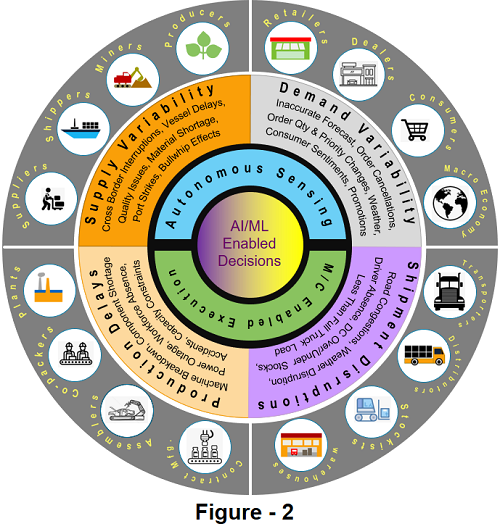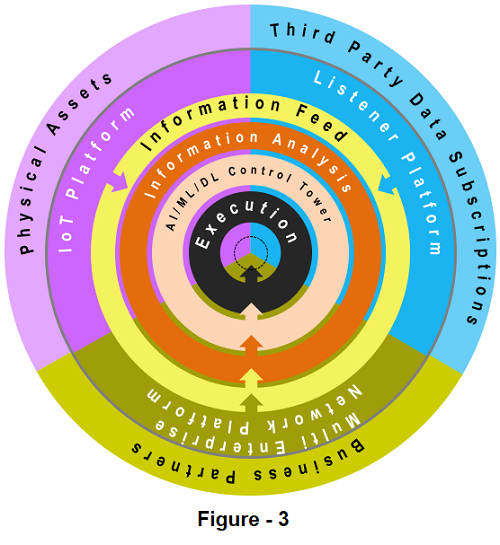Coming soon, supply chain management will experience a sea change in the way businesses will operate. We will see an era of hyper-connectivity where everyone in the ecosystem will exchange real-time information through connected devices. Information will be mostly de-materialized with every single piece of information digitized. Business will be nimbler to proactively sense, analyze and respond to the ecosystem changes through self-learning and cognitive intelligence. Personalized experience and collaborative ecosystem with customers, suppliers, manufacturers and distributors will drive growth. Supply chain visibility will be ubiquitous. In the wake of Business 4.0, a sense of these changes are creating renewed promises for organizations. Organizations will begin adopting a value driven approach to integrate physical assets & digitized processes in real time to reshape their business and respond to market needs faster than ever before.
While these are exciting developments, the maturity level of organizations vary and many are already running into a complex ecosystem of multiple business partners and multiple technology platforms that results in information latency and variability in the flow of goods from other than demand alone. Competitor initiatives contribute to uncertainty as much as customer behavior and procurement decisions. Most organizations still run on disconnected legacy solutions which operate in silos. Their physical assets are also not digitally connected to the software platforms. By virtue of these gaps in information visibility, timeliness and flow, organizations lack nimbleness and agility to respond quickly to any variables caused by disruption or changes in any part of the supply chain ecosystem.
While the maturity level and complexities of organizations vary, companies enjoying a more mature level of digitization and supply chain management have begun to create an autonomous supply chain vision. To move the vision forward, leaders are piloting specific business functions to prepare for the future. The Internet of Things (IoT) is enabling physical-digital system connectivity powered by Artificial Intelligence/Machine Learning/Deep Learning (AI/ML/DL) decision making in a multi-enterprise-business-network creating the infrastructure backbone for an autonomous supply chain.
Break the Chain
Today's supply chain is a commerce network of a common business partner/competitor community (Figure-1). Within each supply chain function, companies need to collaborate with multiple partners for order management, distribution, production and supply.

The flow of information and physical goods happen across supply chain value chain and business partners. This creates a complex network for information sharing and movement of physical goods. Currently however, the information passes sequentially and any disruption happening in one part of the network is not communicated immediately and does not flow quickly enough to other participants in the network.
This results in latency in the network ecosystem and organizations are unable to respond and address disruptions in real time. Thus, it is essential to establish an organizational system that integrates all the business partners with a common hub to improve information exchange. Real time capturing of events and making expedited decisions with AI enabled systems will significantly reduce the latency and communication impacts resulting from variability.
Leverage advanced analytics
The key to an effective Autonomous Supply Chain is to leverage a real time understanding of what is happening in each of the four quadrants as illustrated in Figure-2.

To obtain a holistic understanding and accurately predict impacts, an autonomous supply chain must “sense” variability in real time and analyze and learn from the operational impacts in real time. An autonomous supply chain, however, goes beyond just predicting the impacts and leaving the judgement to planners. It also prescribes solutions to minimize the impacts of the disruptions and saves significant planner's time.
The adoption and implementation of an autonomous supply chain can be applicable to multiple business situations. These might include (i) Demand Variability - The cancellation of an order can cause demand volatility and increase unwanted inventory; (ii) Supply Variability - Inbound shipment or vessel delays can cause component or raw material shortages and affect scheduled production; (iii) Production Delays – Machine breakdowns can cause a cascading impact on production output and can cause order delays; (iv) Shipment Disruptions – Anyone who has experienced this summers’ severe weather knows that these can cause delayed shipments to a customer. An Autonomous Supply Chain should be able to prescribe immediate alternate plans for all the above disruptions saving significant planning time and leaving more time for execution. But how this can be made possible?
Realize the promise
An Autonomous Supply Chain system requires three key attributes – Sense, analyze and prescribe as described below.
Sense: The journey for Autonomous Supply Chains begins with the establishing an analytic foundation/ infrastructure for real time sensing of events and information exchange (Figure-3).

The foundation illustrated above in Figure 3 can be established with the data collection and information flow and exchange from a combination of multiple platforms and solutions. These include:
(1.) Establishing a platform for information exchange with all business partners - Commercial off-the-shelf (COTS) platforms are available to establish multi-enterprise-business-network data connectivity. Leveraging these “ecosystem commerce platforms,” organizations can on-board business partners quickly by virtue of the platform's database of business communities. These platforms allow real time information exchange beyond the individual organizational boundaries. Contextual Information from business partners are available in real time through multi-enterprise business network platforms.
(2.) Listening Platform and Information Subscription – An organization's supply chain is not just limited to its business community ecosystem. Supply chain disruptions can happen outside the control of business partners and information may be available directly from the third party agencies, such as, weather data, vessel status, etc. These new sources of information can be directly subscribed to or captured from various publicly available information on the Internet.
(3.) Physical Assets Connectivity and Events Capture – Supply chain involves physical assets, such as machines, vehicles, fork lifts and warehouses to name a few. Disruptions of services in any physical asset will impact supply chain operations. Hence, it is essential to capture the events from physical asset in real time and feed the information into the digital system for analysis, predictions and prescriptions of an alternate plan.
Physical events, such as, transportation delays, equipment malfunction and production disruption can be captured through GPS tracking mechanisms or with an IoT enabled device. These data can be captured and analyzed for operational impacts and offering alternate plans.
Analyze: Once information is captured, it is fed into an advanced analytic system powered by business rules and/or an artificial intelligence/machine learning/deep learning driven platform for Information Analysis to predict possible disruptions. The business analytics are determined by leveraging a defined dependency matrix based on supply network, business priorities, product category, cost and risk as well as other inputs. A action could be as simple as “predict specific customer orders that would be impacted due to an XYZ component shortage.”
Prescribe: Once the impacts are predicted, an Artificial Intelligence/Machine Learning/Deep Learning (AI / ML/DL) enabled control tower can prescribe alternative solutions to minimize the operational impacts. A Machine Learning (ML) platform is an application of Artificial Intelligence (AI) that can learn from prior experience and improve its learning on its own. A Deep Learning (DL) platform is an advanced form of Machine Learning (ML) that is used for better precision and accuracy, such as image recognition, sound recognition and natural language processing. The algorithms used in a Deep Learning platform can process patterns like human brains and accelerate decision making.
For Autonomous Supply Chain systems, the use of ML and DL can be balanced based on specific business situations - while ML can be used for simpler and faster decision making, DL can be used to gain greater accuracy by compromising response time.
More complexity
In this era of hyper-connectivity and execution speed, business environments are becoming more complex every next day. The Autonomous Supply Chain will not happen overnight. It is a journey of learnings and organizations that begin the journey today will be in a more advantageous position to gain a competitive advantage in responding to market changes.
As digital technologies become more stable and processing powers become more affordable, the Autonomous Supply Chain is going to emerge as a major competitive disruptor.
Hiranmay Sarkar is a Managing Partner with TCS's Consulting and Services Integration Practice. A veteran and thought leader in Supply Chain Management with more than 28 years of experience. In recent years, he has helped organizations shape their autonomous supply chain strategy, draw roadmaps for executions and implement the solutions.
SC
MR


More Events
- Next-Gen SupplyChains: Underpinning your ability to manage complexity and drive innovation
- The Future of Supply Chains: Next-Generation Technology and Beyond
- Thanks to all who made NextGen a success
- Medline Executives’ Keynote to Kick Off NextGen Supply Chain Conference
- NextGen Supply Chain Conference 2022: About our event
- Industry Innovators Take Home 2022 NextGen Supply Chain Awards
- More Events
Latest Podcast

 Explore
Explore
Topics
Events News
- Next-Gen SupplyChains: Underpinning your ability to manage complexity and drive innovation
- The Future of Supply Chains: Next-Generation Technology and Beyond
- Thanks to all who made NextGen a success
- Medline Executives’ Keynote to Kick Off NextGen Supply Chain Conference
- NextGen Supply Chain Conference 2022: About our event
- Industry Innovators Take Home 2022 NextGen Supply Chain Awards
- More Events
Subscribe

Supply Chain Management Review delivers the best industry content.

Editors’ Picks





